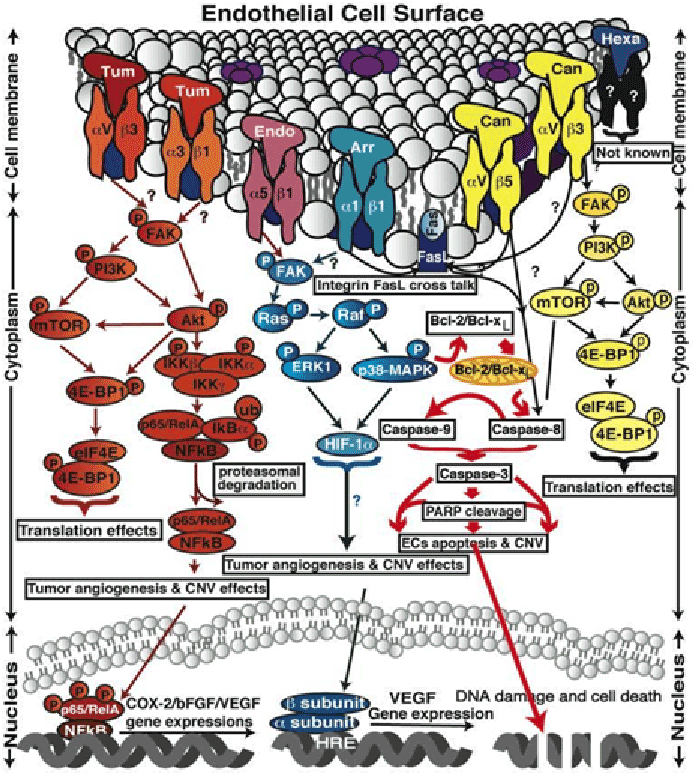
 |
| Figure 1: Schematic illustration of ECM derived endogenous angioinhibitors’ signaling. Tumstatin, endostatin, arresten and canstatin interact with αVβ3/ α3β1, α5β1, α1β1 and αVβ3/ αVβ5 integrins respectively, to inhibit the phosphorylation of focal adhesion kinase (FAK). Tumstatin: It binds to αVβ3 and α3β1 integrins and inhibits phosphorylation of FAK, PI3-K, Akt, mTOR, eIF4E and 4E-BP1 to decrease endothelial cell protein synthesis and proliferation. In addition tumstatin also inhibits NF B mediated signaling in hypoxic conditions leading to the inhibition of COX-2, VEGF and bFGF expressions, resulting in inhibition of hypoxic tumor angiogenesis and LASER induced CNV. Endostatin: It binds to α5β1 integrin and inhibits phosphorylation of FAK, causes inhibition of Ras, Raf, extra cellular signal related kinase-1 (ERK1) and p38 MAPK pathways that leads to inhibition of endothelial cell migration and tube formation and promotes apoptosis in LASER induced CNV. Arresten: It binds to α1β1 integrin and inhibits phosphorylation of FAK, causes inhibition of Ras, Raf, ERK1 and p38 MAPK pathways that leads to inhibition of HIF-1a addition arresten initiates two apoptotic pathways, involving activation of caspase-9 and -8, leading to activation of caspase-3 and PARP cleavage. (a) Arresten activates caspase-3 directly through inhibition of FAK/p38-MAPK/ Bcl-2/Bcl-xL and activation of caspase-9; (b) Integrin a1b1 cross talk with Fas-L through mitochondrial pathway and leads to activation of caspase-8 and-3 in proliferating endothelial cells. Canstatin: It binds to αVβ3/ αVβ5 integrins and inhibits two apoptotic pathways, involving activation of caspase-8 and casoase-9, leading to activation of caspase-3. Canstatin activates procaspase-9 not only through inhibition of the FAK/PI3K/AKT pathways but also by integrins cross talking mitochondrial pathway through Fas-L dependent caspase-8 activation leads to endothelial cell apoptosis in LASER induced CNV models. CM represents cell membrane. Hexastatin: Its receptor and mediated signaling is not yet known. |